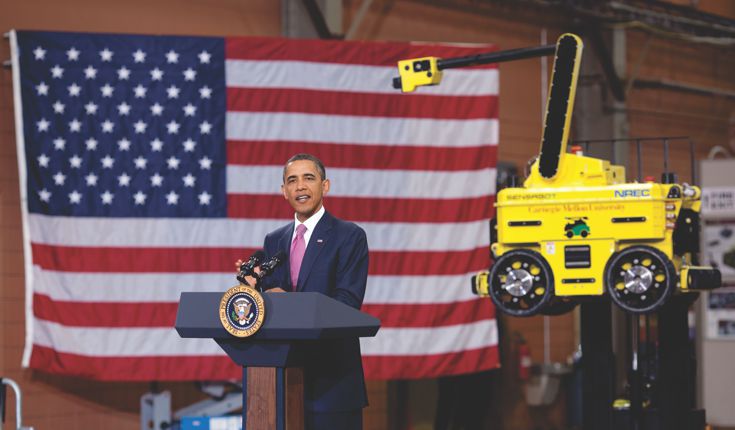Obama’s R&D plan seeks a renaissance in US manufacturing
DOI: 10.1063/PT.3.1215
President Obama’s program to assist US industries in developing advanced manufacturing technologies would devote as much as $500 million annually to R&D projects at NIST, the Department of Energy, the National Institutes of Health, and the Defense Advanced Research Projects Agency (DARPA).
In announcing the Advanced Manufacturing Partnership during a speech at Carnegie Mellon University (CMU) on 24 June, Obama closely adhered to the recommendations of the President’s Council of Advisors on Science and Technology (PCAST), which called for a cooperative R&D program among government, industry, and academia to address the most pressing technological challenges that are common to US manufacturers. Elements of the partnership program include a $100 million Materials Genome Initiative aimed at cutting in half the time and cost required to identify and mass produce new materials for specific applications, a $70 million National Robotics Initiative to develop robots capable of working safely alongside humans, and up to $120 million over several years for the development of more energy-efficient manufacturing processes and materials.
“We’ve launched an all-hands-on-deck effort between our brightest academic minds, some of our boldest business leaders, and our most dedicated public servants from science and technology agencies, all with one big goal, and that is a renaissance of American manufacturing,” Obama said. Initial participants include 6 universities and 12 manufacturers from various industries. Ron Bloom, assistant to the president for manufacturing policy, stressed that the collaboration remains open to other institutions and companies.
Advanced materials manufacturing processes will enable the development of new materials to improve the performance of electric-vehicle batteries, and manufacturing advances will spur the development of organic replacements for petroleum products, Bloom said in a conference call with reporters. “If we can lead in these technologies, we can provide broad applications for manufacturers throughout America to take advantage of them.”
Bloom said the $500 million includes existing R&D programs and new funding proposed in the president’s budget request for fiscal year 2012, currently pending before Congress. But any proposal to expand funding faces an uphill congressional battle, given lawmakers’ preoccupation with reducing federal spending.
Molecular engineering
In conjunction with Obama’s statement, DOE announced a new call for grant proposals from industry and academia for R&D on energy-efficient manufacturing. The materials genome program will strive to construct new materials molecule by molecule. Eric Lander, a Harvard University biologist and cochair of PCAST, said that although the materials genome label wasn’t his idea, it is an apt metaphor, given the human genome project’s directive that all the information generated be made freely available.
Former Google chairman Eric Schmidt, also a PCAST member, said that for many industries, including his own, manufacturing technology is constantly evolving. For that reason, it is becoming more important that R&D facilities be collocated with manufacturing plants. “Manufacturing and innovation are intimately connected,” echoed Lander. Shirley Jackson, a PCAST member and president of Rensselaer Polytechnic Institute, said the manufacturing initiative will address only those areas in which “identifiable market failures” have occurred; she said the advisers took care to ensure that their recommendations did not represent favoritism toward any particular segment of the economy. In its report, PCAST also urged creation of shared facilities and infrastructure to enable small and mid-sized manufacturers to develop improved processes for their own factories.
Under Obama’s partnership plan, NSF will spend $50 million per year as leader of a four-agency National Robotics Initiative to develop robots that work beside or with humans to perform mundane, dangerous, or precise tasks. NASA, NIH, and the Department of Agriculture will collectively add $20 million to the robotics effort.
With its entire annual budget at $3 billion, DARPA plans to spend more than $1 billion over five years on developing innovative manufacturing technologies for defense industries. During Obama’s visit to CMU, DARPA showed off an “experimental crowd-derived combat support vehicle” as an example of a collaboration in innovative manufacturing. Small businesses, universities, and the public had been invited to submit their ideas for a vehicle to be used in combat resupply and medical evacuation missions. The winning design, chosen from the more than 160 credible proposals received, was built in less than 14 weeks by Local Motors.
Also as part of the initiative, Procter & Gamble (P&G) will donate high-performance computing software that it developed several years ago in collaboration with Los Alamos National Laboratory. The household-products giant used the fluid dynamics code to improve the manufacturing of diapers and saved itself $500 million in the process, Obama said. The code is being made freely available to small and medium-sized companies that are suppliers to P&G and to three other large original-equipment manufacturers through a recently formed consortium organized by the nonprofit Council on Competitiveness (see PHYSICS TODAY,July 2011, page 27

President Obama shares the stage with a robot as he announces his Advanced Manufacturing Partnership plan during a visit to Carnegie Mellon University on 24 June.
OFFICIAL WHITE HOUSE PHOTO BY PETE SOUZA

More about the Authors
David Kramer. dkramer@aip.org
